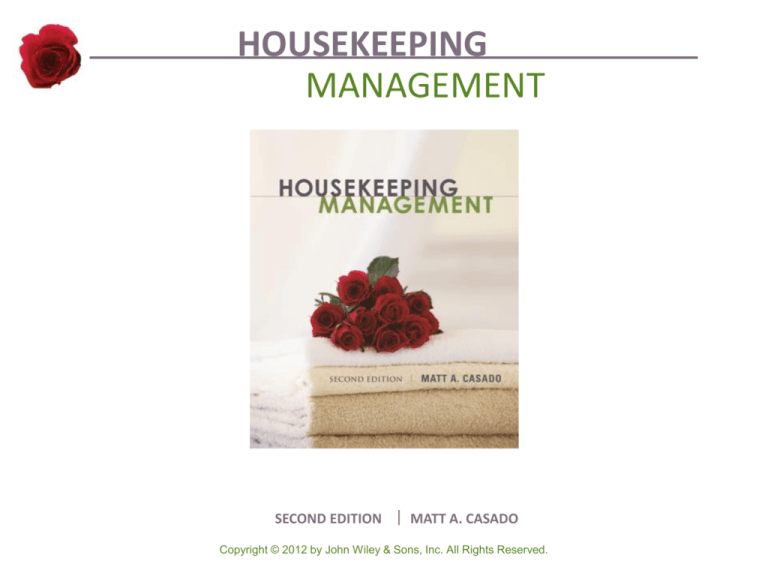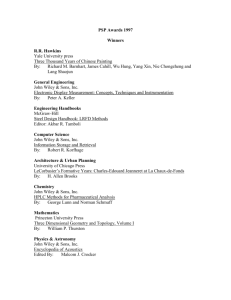
HOUSEKEEPING
MANAGEMENT
SECOND EDITION ︳MATT A. CASADO
Copyright © 2012 by John Wiley & Sons, Inc. All Rights Reserved.
CHAPTER 5
Characteristics of Housekeeping Equipment and Supplies
Main Concepts
• Housekeeping F.F.&E, Software, and Department
Equipment
• Purchasing Cleaning Supplies
• Housekeeping Chemicals
• Hazardous Communication (HazComm)
• Non-Reusable Guest Supplies
• Reusable guest Supplies
• Uniforms
• Bed Linen, Bath Linen, and Napery Characteristics
• Linen Cost per Use and Par Levels
• Linen Control
Copyright © 2012 by John Wiley & Sons, Inc. All Rights Reserved.
HOUSEKEEPING FURNITURE, FIXTURES
AND EQUIPMENT (FF&E)
• Lodging establishments must maintain interior
design consistency throughout the property.
• Furniture should be solidly built, easy to
maintain, functional, and attractive.
• Surveys consistently show that guests put
comfortable mattresses as top guest amenities.
– Mattresses should be protected with mattress covers
and rotated often to avoid contour formation.
Copyright © 2012 by John Wiley & Sons, Inc. All Rights Reserved.
HOUSEKEEPING FURNITURE, FIXTURES
AND EQUIPMENT (FF&E) (CONT.)
• Fixtures in guestrooms and public areas should
complement the overall décor.
• Carpets should match their color, texture, and
pattern with the design of the area.
• Carpets should be dense to the point of not
showing the backing when bending a piece with
both hands.
• The quality of carpets is ascertained by its face
weight (number of ounces of yarn per square
yard).
Copyright © 2012 by John Wiley & Sons, Inc. All Rights Reserved.
HOUSEKEEPING FURNITURE, FIXTURES
AND EQUIPMENT (FF&E) (CONT.)
• Guestrooms should be equipped with technology
features, such as:
– High-speed wireless Ethernet with private VLAN.
– TV with access to movies on demand and video games
for kids.
– TV with Internet access
– Sufficient outlets for charging cell phones, cameras,
and laptops.
• In-room strongboxes are necessary for guests to
safeguard personal belongings.
Copyright © 2012 by John Wiley & Sons, Inc. All Rights Reserved.
HOUSEKEEPING SOFTWARE
• These are the depreciable fixed assets that are not
furniture or equipment, such as bedspreads,
mattress covers, blankets, pillows, and window
coverings.
• Bedspreads should complement the motif, color,
and design of the room. Fabrics made of 100%
polyester are soil resistant and easier to clean than
polycotton.
• Blankets should be good insulators and
manufactured of fire retardant material.
Copyright © 2012 by John Wiley & Sons, Inc. All Rights Reserved.
HOUSEKEEPING SOFTWARE (CONT.)
• Pillows should feature fills of good quality so they
spring back into shape easily. Lumpy, heavier fills
are indications of inferior grade.
• The synthetic covering of pillows should be fire
retardant, stain proof, and able to withstand
frequent washings.
• Feather pillows should be provided to guests on
request.
• Window coverings must be resistant to direct
sunlight.
Copyright © 2012 by John Wiley & Sons, Inc. All Rights Reserved.
HOUSEKEEPING DEPARTMENT
EQUIPMENT
• Housekeeping carts must be light and maneuverable to
be pushed by one person from floor to floor and into and
out of service elevators.
• Carts should be contoured with rubber bumpers to
protect walls and wall corners.
• Vacuum cleaners must be heavy-duty and capable of
providing one-pass cleaning.
• Besides vacuums to service guestrooms, the department
should have large-area, wet/dry, and back vacuums.
Copyright © 2012 by John Wiley & Sons, Inc. All Rights Reserved.
PURCHASING CLEANING SUPPLIES
• The main factors to consider when buying cleaning
supplies should be:
– Quality, product availability, purveyor service, and price.
• Bulk purchasing of chemicals is usually cheaper,
but may actually be labor intensive and therefore
more costly.
• Pre-measured chemicals do not require much
handling but are quite expensive.
• Chemical dispensers can be a good alternative to
both bulk and pre-measured products.
Copyright © 2012 by John Wiley & Sons, Inc. All Rights Reserved.
HOUSEKEEPING CHEMICALS
• Three major purposes of chemicals used in
housekeeping are to:
1. remove dirt
2. destroy harmful microorganisms
3. beautify furniture, fixtures and surfaces
• The strength of cleaning chemicals is measured
on the pH scale.
• The pH scale goes from 1 to 14, 1 indicating very
acidic and 14 very alkaline solutions.
Copyright © 2012 by John Wiley & Sons, Inc. All Rights Reserved.
HOUSEKEEPING CHEMICALS (CONT.)
• Restroom and bathrooms require strong acidic
cleaners to remove lime and rust deposits.
• Strong alkaline cleaners are as effective as
degreasers.
• Disinfectants are germicidal chemicals that kill
microorganisms and prevent them from
multiplying.
• Antibacterial liquid hand soap is important in
fighting infectious diseases and should be used in
back-of-the-house areas.
Copyright © 2012 by John Wiley & Sons, Inc. All Rights Reserved.
HOUSEKEEPING CHEMICALS (CONT.)
• Floor care chemicals generally used on
floor surfaces are:
– Strippers, sealers, and finishes.
• Carpet shampoos should be soil-retardant
to protect against dirt and stains.
• Spot removers should be used on carpets
to remove tar, grease, lipstick, and graffiti.
Copyright © 2012 by John Wiley & Sons, Inc. All Rights Reserved.
HAZARD COMMUNICATION
(HAZCOMM)
• The Occupational Safety and Health
Administration (OSHA) requires that employees
handling chemicals are informed of the risks
these chemicals pose, that the employer provides
appropriate training, and how to use them safely.
• The manufacturer’s Material Safety Data Sheet
(MSDS) and labels for each hazardous chemical
must be displayed in the workplace.
Copyright © 2012 by John Wiley & Sons, Inc. All Rights Reserved.
NON-REUSABLE GUEST SUPPLIES
• Also called amenities, non-reusable guest
supplies are items that guests are expected to
use up.
• The higher the room rate is, the more
luxurious amenities should be.
Copyright © 2012 by John Wiley & Sons, Inc. All Rights Reserved.
REUSABLE GUEST SUPPLIES
• Unlike non-reusable guest supplies,
reusable guest supplies can be used
multiple times.
• The quality of reusable guest supplies
usually varies with the type of lodging
establishment; while economy properties
offer the bare-essential items, luxury
establishments’ are in most cases quite
sophisticated.
Copyright © 2012 by John Wiley & Sons, Inc. All Rights Reserved.
UNIFORMS
• Uniforms for housekeeping personnel
should be functional, good looking,
comfortable, and able to stand frequent
washings.
• It is important to establish an adequate par
of employee uniforms.
• Often, the housekeeping department is in
charge of processing the uniforms for all
the property’s departments.
Copyright © 2012 by John Wiley & Sons, Inc. All Rights Reserved.
BED LINEN CHARACTERISTICS
• The fabric for bed linen and pillowcases is usually
a blend of 50% cotton and 50% polyester.
• All other factors being equal, bed linen fabrics are
better when their thread count is higher.
• Muslin is a carded type of fabric while percale is
made of combed material.
• Plain-weave textiles are made by interlacing the
vertical with the horizontal thread.
• Twill has an extra diagonal pattern, making the
material stronger.
Copyright © 2012 by John Wiley & Sons, Inc. All Rights Reserved.
BATH LINEN CHARACTERISTICS
• Towels, washcloths, and bath mats are
usually made of a 100%-cotton pile fabric
called terrycloth.
• The quality of terrycloth is determined by
the weight of the item.
Copyright © 2012 by John Wiley & Sons, Inc. All Rights Reserved.
NAPERY CHARACTERISTICS
• The housekeeping department is usually in
charge of processing the F&B department’s
napkins and table cloths.
• Momie cloth is the least expensive material. It is
usually a plain weave 50/50 cotton/polyester
blend.
• Damask is a twill-woven fabric with a glossy, silky
appearance.
• The drape of a tablecloth should be level with a
chair’s seat or fall at least 12 inches below the
table’s edge.
Copyright © 2012 by John Wiley & Sons, Inc. All Rights Reserved.
LINEN PURCHASING
• Linens can be purchased directly from the
mill or from regional or local brokers.
• Minimum standards for linens have been
established by the federal government
regarding shrinkage, strength, and so on.
• The main factors to consider when
purchasing linen are: durability, laundry
costs, and purchase price.
Copyright © 2012 by John Wiley & Sons, Inc. All Rights Reserved.
LINEN COST PER USE
• The cost per use is arrived at by multiplying
the total number of washings expected of
the item (its life expectancy) by its weight
in pounds, times its pre-established
laundry cost per pound, plus the purchase
price of the article, divided by the same life
expectancy.
Copyright © 2012 by John Wiley & Sons, Inc. All Rights Reserved.
COST PER USE FORMULA
Weight in pounds × laundry cost × life expectancy + purchase cost
Life expectancy
Copyright © 2012 by John Wiley & Sons, Inc. All Rights Reserved.
LINEN PAR LEVELS
• The amount of linen needed to outfit the
property at 100% occupancy is defined as
one par level.
• Usually, lodging properties require
between 2.5 and 4 par levels.
• Each establishment should calculate the
number of pieces of linen to have in stock
at all times.
Copyright © 2012 by John Wiley & Sons, Inc. All Rights Reserved.
LINEN CONTROL
• Physical inventories of linens should be
conducted regularly to ascertain losses and
to bring the stocks to their original levels.
• When taking inventory, all items in all
locations should be counted.
Copyright © 2012 by John Wiley & Sons, Inc. All Rights Reserved.
LINEN CONTROL (CONT.)
• A sample inventory form can be
summarized as follows:
Beginning inventory
+ purchases for the month
- documented discards for the month
- current physical inventory
= losses
Copyright © 2012 by John Wiley & Sons, Inc. All Rights Reserved.







